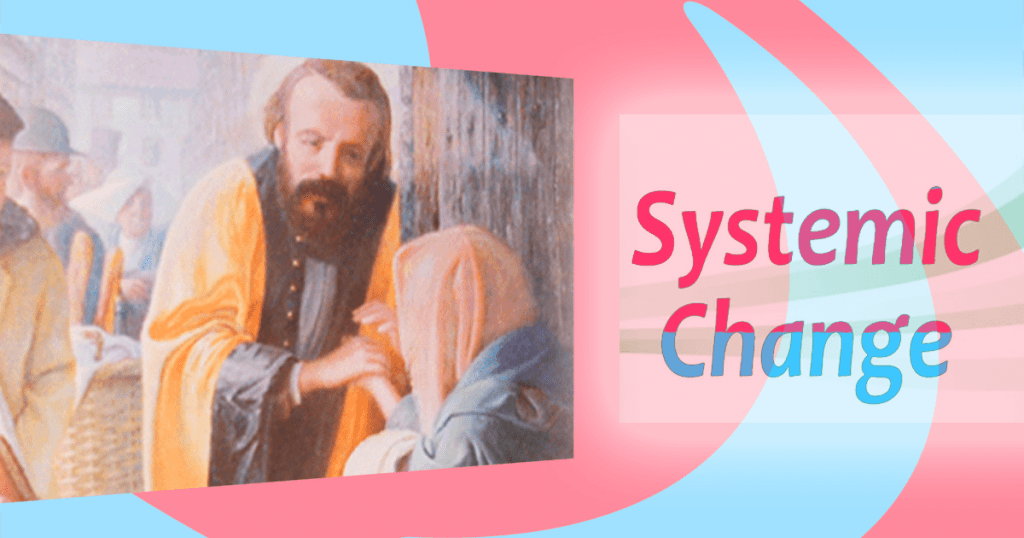
At the conclusion of an excellent article, Frederick Ozanam: Systems Thinking and Systemic Change, noted Ozanam researcher Ray Sickinger, points out that the Society of St. Vincent de Paul, for which Ozanam was such an inspiration, is a learning organization which has often been overlooked in its genuinely transformative character.
Learning organization
If noted systems thinker Peter Senge’s five disciplines (1) are applied to Ozanam’s thought, work, and strategies, significant correspondence and resonance are apparent. Indeed, Senge claims that a “learning organization is a place where people are continually discovering how they create their reality. And how they can change it.”
Ozanam diligently worked to make the Society of Saint Vincent de Paul such a learning organization. It would be disingenuous, then, to fail to recognize that Ozanam was attuned to the realities and need for fundamental change in the religious, political, economic, and social systems of his day, and that he sometimes thought systemically, planting seeds which grew into genuine hope for those living in poverty.
Systemic change
An examination of five generally accepted criteria for systemic change projects reveals that at least in its initial history the Society fulfilled, or came decidedly close to fulfilling, each of these criteria.
The first criterion is long-range social impact: the project “helps to change the overall life-situation of those who benefit from it.” The Society of Saint Vincent de Paul helped to address the multiple needs of many individuals, improving their lives.
According to Sickinger the early letters of the Society provide ample evidence that those aided by the Society often found their way to a better, or more sustainable, way of life. The Rule today stresses that the Society is “commited to identifying the root causes of poverty and to contributing to their elimination.”
The second criterion is sustainability: “The project helps create the social structures that are needed for a permanent change in the lives of the poor, like employment, education, housing, the availability of clean water and sufficient food, ongoing local leadership, etc.” Especially through its Rule, the Society ensured its own sustainability to the present day. Its members provided not only for immediate needs, but also opportunities for appropriate food supplies, apprenticeships, and other forms of employment, as well as education. Many of these eventually became the organized “special works” of the Society. No work of charity was foreign to the Society.
The third criterion is replicability: “The project can be adapted to solve similar problems in other places. The philosophy or spirituality that grounds the project, the strategies it employs and the techniques that it uses can be applied in a variety of circumstances.”
While the fourth criterion is scope: “The project actually has spread beyond its initial context and has been used successfully in other settings in the country where it began, or internationally, either by those who initiated it, or by others who have adapted elements of it.” In the case of both, the Society expanded quickly not only in France, but elsewhere. Its principles and strategies were easily transferable to other countries and other needs. In 1855, two years after Ozanam’s death, the Society had a presence in approximately thirty- ve countries. It currently exists in more than 140 countries throughout the world.
The fifth and final criterion is innovation: “The project has brought about significant social change by transforming traditional practice. Transformation has been achieved through the development of a pattern-changing idea and its successful implementation.” The Society was actually counter-cultural in its day, aspiring both to resist and to change the systems of thought and practice that were part of French social, economic, political, and religious life.
It would certainly be disingenuous to claim that Frédéric Ozanam was knowingly engaged in systemic change initiatives, because the phrase “systemic change” was not in the vocabulary of his day. However, if Ozanam’s thought, work, and strategies are compared to the Vincentian definition of systemic change, and to the criteria and strategies for creating systemic change recommended in Seeds of Hope, remarkable similarities and significant correlation are evident.
As Seeds of Hope proclaims: “Hope is a tiny seed that contains the germ of life. When watered, it sprouts and generates sturdy plants, beautiful flowers, fruit bushes and trees.” In thought and through his works, Frédéric Ozanam brought such hope to a despairing world. As Pope Saint Pius XII said of him: “The mustard seed sown by Ozanam in 1833 is to-day [sic] a mighty tree.” (2)
(1) Senge, The Fifth Discipline, 13
(2) Baunard, Ozanam in his correspondence.







0 Comments